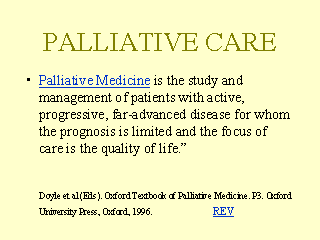
The conceptual model we have been using of education, legislation and national
leadership is modified for palliative care as follows:
Education
* Mass public education on need for and effectiveness of palliative care
* Educate health care professionals such as physicians, nurses and pharmacists on the
value
and techniques of pain and symptom management.
* Educate other stakeholders such as health-care policy makers, administrators and drug
regulators on the importance of providing palliative care.
* In all cases stress the humanitarian imperative of the relief of suffering
* Utilize the influence of the mass media
* Consider a survey to assess the current effectiveness of pain and symptom
relief.
Drug Availability
* Alter health care regulations and legislation to make drugs, especially opioids,
available.
* Implement improvements in the prescribing, distributing, dispensing and
administration of drugs, especially opioids.
Governmental Policy
* Promote collaboration across disciplines and ministries.
* Establish national or state policy that enables the alleviation of chronic cancer
pain.
Click the hyperlink on the slide for details.
|


